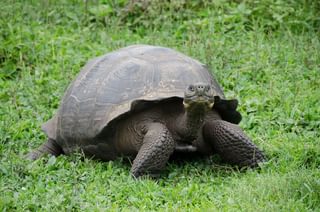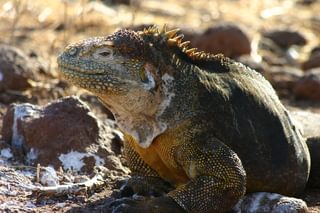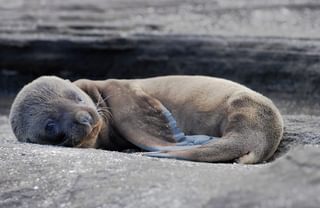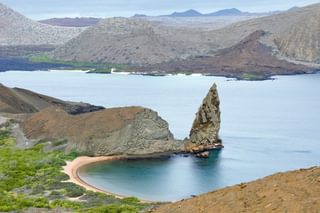Speak to a Galapagos expert today.
A tailor-made itinerary just for you.

Amanda
Travel Expert
For wildlife enthusiasts, the Galapagos Islands are nothing short of a paradise on Earth.

Situated in the midst of the Pacific Ocean, approximately 600 miles off the coast of Ecuador are the enchanting Galapagos Islands. This volcanic archipelago, consisting of nineteen main islands and numerous islets, is renowned for its unparalleled natural beauty, extraordinary biodiversity, and profound significance in the field of evolutionary biology. The islands' stark and rugged landscapes, pristine beaches, and crystal-clear waters have been captivating explorers and nature enthusiasts for centuries. Read more to learn about twenty of the coolest animals you can see on a Galapagos Holiday. Discover the top five iconic animals of the Galapagos, their lesser-known brethren, five of the endemic bird species, and five marine species to keep an eye out for.


Biological Significance of the Galapagos Islands
For wildlife enthusiasts, the Galapagos Islands are nothing short of a paradise on Earth. Charles Darwin's historic visit to the Galapagos in the early 19th century inspired his groundbreaking theory of natural selection, forever linking these islands to the study of evolution. Today, the Galapagos continue to be a living laboratory and a testament to the wonders of the natural world.
What makes the Galapagos truly exceptional is its incredible array of unique and often endemic species. It's a place where animals have evolved in isolation, adapting to their specific environments in extraordinary ways. Here, you can encounter giant tortoises on Santa Cruz Island that can live for over a century, blue-footed boobies with their striking azure feet on San Cristóbal Island, marine iguanas that forage underwater on Isabela Island, and playful sea lions that share the beaches with you all across the archipelago.
The Galapagos Islands provide unrivalled opportunities for close encounters with wildlife. Visitors can snorkel alongside curious sea turtles, swim with graceful manta rays, and even come face to face with hammerhead sharks in the deep blue waters. Birdwatchers are treated to sightings of rare species like the waved albatross and Galapagos penguins, which are found nowhere else on the planet.
The islands are a testament to the importance of conservation and sustainable tourism. Efforts to protect this fragile ecosystem ensure that future generations of wildlife enthusiasts can continue to explore and marvel at the wonders of the Galapagos Islands. Whether you're a biologist, photographer, or simply a nature lover, the Galapagos offers an experience that is both humbling and awe-inspiring, making it a must-visit destination for anyone seeking a deeper connection with the natural world.
If you're interested in seeing these biological wonders in real life, take a look at our Galapagos Wildlife and Ecuador Bears itinerary.


The Galapagos Islands are famous for these five amazing creatures.

1. Galapagos Giant Tortoise (Chelonoidis niger): Galapagos giant tortoises are the archipelago's emblematic species. These gentle giants can weigh up to 900 pounds and live for over a century, making them some of the longest-lived vertebrates on Earth. These remarkable reptiles are a testament to the importance of conservation, as they were once hunted to the brink of extinction but have since made a remarkable recovery.
Where to find them: Each island in the Galapagos has its own distinct subpopulation of giant tortoises, with unique shell shapes and sizes. They are found in large numbers on San Cristobal Island in particular.

2. Blue-Footed Boobies (Sula nebouxii): Blue-footed boobies are instantly recognizable by their striking bright blue feet. These seabirds are renowned for their comical mating dances, during which they lift their feet high and perform intricate steps to attract a mate. Blue-footed boobies are expert divers and plunge headfirst into the ocean to catch fish.
Where to find them: These amusing creatures are found in the greatest numbers of North Seymour Island but can also be found on Española, Fernandina, Floreana, Isabela, Pinzon, and Santa Cruz Islands.

3. Marine Iguanas (Amblyrhynchus cristatus): Marine iguanas are the world's only sea-going lizards, and they are found exclusively in the Galapagos Islands. These remarkable reptiles have adapted to a marine lifestyle by foraging for algae in the ocean. They have specialized glands near their nostrils that expel excess salt, a critical adaptation for their saltwater diet. Marine iguanas are known for their distinctive appearance, with dark, camouflaging coloration and spiky crests along their backs.
Where to find them: They can often be seen basking in the sun to regulate their body temperature on the islands of Isabela, Española, Santa Cruz, Fernandina, and Floreana.

4. Galapagos Penguins (Spheniscus mendiculus): Galapagos penguins are the only penguin species to live north of the equator, making them the most northerly penguins in the world. They are perfectly adapted to the warm waters of the Galapagos, where they can be seen darting through the ocean in search of prey. These small penguins are excellent swimmers and divers, relying on their agility to catch fish.
Where to find them: These adorable birds are mostly found on Isabela and Fernandina Islands.

5. Galapagos Sea Lions (Zalophus wollebaeki): Galapagos sea lions are the playful and charismatic ambassadors of the archipelago. These social animals can often be found lounging on sandy beaches or engaging in acrobatic displays in the water. They are excellent swimmers and hunters, preying on the abundant fish in the surrounding waters. Galapagos sea lions are known for their curiosity and interaction with humans, making them a highlight for visitors.
Where to find them: These fun-loving creatures can be found on almost any coastline in the archipelago.
Of course, there are an abundance of unique endemic species across the archipelago that are less famous than their iconic neighbours. Some of these are as follows:

1. Galapagos Flightless Cormorant (Nannopterum harrisi): The Galapagos flightless cormorant is a true anomaly among cormorant species. It has lost the ability to fly, instead evolving powerful swimming adaptations. Their wings are small and rudimentary, but their legs and feet are robust and webbed, ideal for underwater propulsion. These birds have superb diving capabilities, reaching depths of up to 30 meters to hunt for fish and crustaceans. They are the only cormorants in the world that are completely flightless.
Where to find them: Find them swimming around on the northwestern coast of Isabela and the east coast of Fernandina.

2. Galapagos Land Iguanas (Conolophus subcristatus): Galapagos land iguanas are an iconic reptilian species of the archipelago. They are known for their bright yellow and orange skin, contrasting with the arid landscape. These herbivorous reptiles play a vital role in dispersing plant seeds throughout the islands. They are often seen basking in the sun to regulate their body temperature. Land iguanas have a unique method of conserving water, extracting moisture from the prickly pear cactus pads, a significant part of their diet.
Where to find them: North Seymour, South Plaza, Fernandina, Isabela, Santa Cruz, Baltra, and Santiago islands. Important to note, that these iguanas have been facing a severe decline in population and it is only due to conservation efforts that they are once again found on Santiago Island.

3. Galapagos Lava Gull (Leucophaeus fuliginosus): endemic to the Galapagos with its charcoal-gray plumage, this gull blends into volcanic landscapes but stands out on the pristine white beaches of the islands. It's a relatively small species with an unmistakable appearance. The lava gull is known for its opportunistic scavenging behavior, often seen near coastal areas and fishing boats, making the most of the abundant marine life in the Galapagos waters. It is perhaps the rarest species of gull in the world, with a population of less than 600, entirely contained in the Galapagos archipelago.
Where to find them: Around human settlements on San Cristobal, Genovesa, Santa Cruz, and Isabela Islands.

4. Galapagos Fur Seals (Arctocephalus galapagoensis): a smaller and more delicate relative of the sea lion. They have a dense fur coat that provides insulation in the cool waters of the archipelago. Compared to sea lions, fur seals have external larger ear flaps and can rotate their hind flippers forward, enabling them to move gracefully on land. Galapagos fur seals are known for their agility in the water, where they hunt for fish and squid.
Where to find them: These charming creatures are often spotted along any rocky shoreline in the archipelago. Try Darwin Bay on Genovesa for an easily accessible viewing location.

5. Lava Lizards (Microlophus): Lava lizards in the Galapagos are captivating miniature reptiles that thrive in the challenging volcanic landscape. These small and agile creatures, mainly found on rocky shores and lava fields, are known for their vibrant coloration and territorial behavior. Males sport striking hues, including shades of green and red during the breeding season, making them a sight to behold. Lava lizards are an essential part of the archipelago's ecosystem, contributing to seed dispersal and insect control.
Where to find them: Galapagos lava lizards inhabit most of the central islands except for Genovesa, Darwin, and Wolf. They dwell in lowlands near shorelines, often with sunbathing marine iguanas.
Beyond the abovementioned creatures, the Galapagos Islands are also generally an absolute haven for bird enthusiasts. This archipelago is a veritable birder's paradise, boasting a remarkable diversity of avian species and offering unparalleled opportunities for birdwatching.
With over 200 documented bird species, the Galapagos Islands are home to an array of unique and often endemic avian treasures. The islands' isolation, varying ecosystems, and distinct microclimates have contributed to the evolution of a remarkable avifauna. Birdwatchers are in for a treat, as they can explore the diverse habitats, from coastal shorelines and arid deserts to lush highland forests, each harbouring its own feathered wonders.
To chance seeing these beautiful birds, look at our Active Ecuador and Galapagos from ashore trip idea.


1. Waved Albatross (Phoebastria irrorata): The Galapagos albatross, also known as the waved albatross, is a magnificent seabird and one of the world's rarest albatross species. They are renowned for their spectacular courtship rituals, which involve intricate dances and synchronized head-bobbing displays. These large birds have impressive wingspans, enabling them to glide effortlessly over the ocean for hours or days without flapping their wings. Galapagos albatrosses are known for their incredible long-distance migrations and are often seen soaring above the open sea.
Where to find them: Española Island is the primary breeding ground for these magnificent seabirds.

2. Galapagos Mockingbird (Mimus parvulus): The Galapagos mockingbird is another avian icon, known for its curious and fearless nature. These birds are renowned for their diverse songs and fearless behavior around humans, often approaching visitors with a friendly demeanor. Each island has its unique subspecies of mockingbirds, making them fascinating subjects for observation.
Where to find them: There are six subspecies of the Galapagos mockingbird that occupy specific islands. They can be found almost everywhere except San Cristobal, Floreana, and Espanola.

3. Darwin's Finches (Geospiza): The Galapagos Islands are famous for Darwin's finches, a group of small land birds with distinct beak shapes adapted to their specific diets. Birdwatchers can spot these birds (not true finches, but rather tanagers) on various islands, each species showcasing its remarkable evolutionary adaptations. Observing their foraging behaviors and interactions is a unique opportunity to witness natural selection in action.
Where to find them: On every island! Different finches are found on different islands but their distribution is varied.

4. Magnificent frigatebird (Fregata magnificens): There are two endemic species of frigatebirds in the Galapagos, the Great Frigatebird and the Magnificent Frigatebird, who grace the skies with their impressive wingspans and aerial acrobatics. Males display inflated red-throat pouches during the breeding season to attract mates, making them striking and unmistakable. These seabirds are expert flyers, capable of soaring for hours on thermal currents. Frigatebirds are also notorious kleptoparasites, often stealing food from other birds in mid-air, which can be thrilling to witness.
Where to find them: These beautiful birds can be seen on most islands but their largest breeding sites are on Floreana, Genovesa, San Cristobal and North Seymour.

5. Galapagos Hawk (Buteo galapagoensis): The Galapagos hawk is the archipelago's only bird of prey and is a top predator in the ecosystem. These raptors have adapted to the unique environment of the islands by evolving a relatively small size compared to mainland hawks. They are skilled hunters, preying on a variety of creatures, including marine iguana hatchlings and seabirds. Galapagos hawks are known for their striking plumage, which varies from island to island, and their powerful beaks and talons. They are an essential part of the Galapagos' ecological balance, controlling populations of smaller animals.
Where to find them: Mostly on Isabela and Fernandina.
Beyond these notable species, birdwatchers in the Galapagos can encounter a multitude of other avian wonders, including the birds mentioned above, the Nazca booby, the red-footed booby, flamingoes, and many more. The Galapagos archipelago provides bird enthusiasts with a remarkable blend of beauty, biodiversity, and scientific significance, making it a destination that promises unforgettable avian encounters and a deeper understanding of the intricate web of life on these enchanting islands. Whether you're a seasoned birder or a novice enthusiast, the Galapagos is an incredible playground for your birdspotting adventures.
From the land to the sky, now the seas; beneath the pristine waters that surround the Galapagos Islands lies a mesmerizing marine world that is as extraordinary as the terrestrial realm. For snorkellers and divers, the Galapagos archipelago offers a once-in-a-lifetime opportunity to explore the mesmerizing depths of the Pacific Ocean and encounter some of the most incredible marine life on the planet.
See these incredible marine species on our Galapagos cruise trip idea.

1. Hammerhead Sharks (Sphyrna): The Galapagos Islands are celebrated as one of the world's premier destinations for hammerhead shark encounters. These enigmatic creatures, known for their distinctive hammer-shaped heads, gather in large schools around the islands. Diving with hammerhead sharks is a heart-pounding experience, as you'll witness these magnificent predators gracefully gliding through the deep waters, often in close proximity to divers.
Where to find them: Off the coast of the northern islands, such as Wolf and Darwin.

Galapagos Green Turtle: the only sea turtle that nests exclusively in the Galapagos Islands. They are differentiated from other sea turtles by their serrated lower jaws and a single pair of eye scales. Interestingly, adults green turtles are herbivores, but the juveniles are more opportunistic in their diet and will occasionally eat fish. Mating occurs in the warm summer months, and females lay their eggs at night, returning to the ocean before sunrise. The gender of hatchlings depends on incubation temperatures, with higher temperatures resulting in more females.
Where to find them: In most of the coastal waters around the islands.

Red-lipped batfish (Ogcocephalus darwini): this endemic Galapagos species is a peculiar underwater wonder. Its striking appearance includes bright red lips that resemble lipstick, making it an icon of these unique waters. These fish are not strong swimmers; instead, they "walk" on the ocean floor using modified fins as legs. They thrive in the deep sea, residing at depths between 30 and 76 meters.
Where to find them: They can be found in most coral reefs around the islands.

4. Whale Sharks (Rhincodon typus): colossal creatures, the world's largest fish species, can reach lengths of up to 40 feet or more. Distinguished by their checkerboard-like patterns of white spots on a deep blue-gray canvas, they offer a breathtaking spectacle for snorkelers and divers lucky enough to encounter them. The Galapagos Islands are a renowned hotspot for whale shark sightings, particularly around the Wolf and Darwin Islands. Swimming alongside these magnificent behemoths is a surreal and unforgettable experience in this pristine marine sanctuary.
Where to find them: These impressive fish can be spotted between June and November off the coast of Wolf and Darwin Islands.

5. Humpback Whales (Megaptera novaeangliae): these majestic marine mammals are known for their distinctive appearance, including long pectoral fins and knobbly heads. Humpback whales are frequent visitors to the Galapagos waters, particularly during their migration periods. They are often spotted breaching, tail-slapping, and engaging in other spectacular behaviors, making them a popular attraction for whale-watching tours in the region. The Galapagos serves as a vital breeding and calving ground for humpback whales.
Where to find them: In the western waters of the islands, around Isabela and Fenandina Islands.
Popular Snorkelling and Diving Sites
The Galapagos Islands are peppered with renowned snorkelling and diving sites, each with its unique allure. Whether you're a novice snorkeler or an experienced diver, there's something for everyone in this underwater paradise. Some of the most popular sites include Kicker Rock (Leon Dormido), Gordon Rocks, Devil's Crown, and Darwin and Wolf Islands. These locations offer a chance to witness the breathtaking diversity of marine species and ecosystems that thrive in the archipelago's crystal-clear waters.
Exploring the marine world of the Galapagos is a journey into an alien realm of vibrant coral reefs, dramatic drop-offs, and underwater caves. It's a place where you can witness the delicate dance of marine life, from playful sea lions and colourful reef fish to elusive whale sharks and Galapagos penguins darting through the water. Whether you're a seasoned diver seeking adrenaline-pumping encounters or a snorkeller looking for serene moments in the underwater realm, the Galapagos Islands offer an immersive and unforgettable marine experience.


Unique geography creating incredible biodiversity
One of the most striking aspects of the Galapagos Islands is their unique geological heritage. These islands emerged from the depths of the ocean as a result of volcanic activity, a process that continues to shape their landscapes. Each island possesses its own distinct geological character, from the towering volcanoes of Isabela to the eroded craters of Española.
The Galapagos' geological diversity provides a glimpse into the dynamic forces that have shaped our planet over eons. It's a place where one can walk on lava fields, explore collapsed lava tunnels, and witness the dramatic contrast between the barren volcanic terrain and lush, green highlands.
Intriguingly, the Galapagos' importance transcends its biological and geological uniqueness; it serves as a beacon for conservation and sustainable tourism, ensuring that this natural wonder remains a source of inspiration and study for generations to come.
Be a part of maintaining the beauty of this amazing location with a tailor-made Far and Wild Galapagos trip.

The unique ecosystems of the Galapagos are a living testament to the intricate dance of life on our planet. These volcanic islands, isolated in the Pacific Ocean, boast a diverse range of habitats, each teeming with specialized flora and fauna. Yet, the fragile balance of this natural wonderland faces both challenges and opportunities in the realm of conservation.
The Galapagos Islands encompass a wide array of ecosystems, each with its distinct characteristics and inhabitants. The islands can be broadly categorized into coastal, lowland, and highland regions.

Coastal Ecosystems: The coastlines of the Galapagos are rich with life. Sandy beaches provide nesting grounds for sea turtles, while rocky shores are home to marine iguanas and sea lions. Mangrove forests offer shelter to countless bird species and juvenile fish. The nutrient-rich waters surrounding the islands support diverse marine life.
Lowland Ecosystems: The arid lowlands of the Galapagos are characterized by sparse vegetation and cacti. Here, land iguanas and giant tortoises roam. The distinctive Galapagos prickly pear cactus plays a vital role in the ecosystem, providing food and nesting sites for various species.
Highland Ecosystems: As you ascend into the highlands, lush forests and green valleys emerge. These areas are inhabited by unique bird species, including the iconic Galapagos hawk, as well as the rare and elusive Galapagos giant tortoises. These giant reptiles play a crucial role in seed dispersal and ecosystem health.
Threats to Galapagos Wildlife and Conservation Initiatives
Despite dedicated conservation efforts, the Galapagos face several challenges. Invasive species, introduced by human activity, threaten the survival of native wildlife. Feral animals like rats, cats, and goats disrupt delicate ecosystems and compete for resources. Climate change poses another significant threat, with rising sea levels and warming oceans impacting marine species and habitats.
To combat these challenges, conservation initiatives focus on eradicating invasive species, restoring native vegetation, and implementing strict regulations for tourism and fishing. Conservationists strive to strike a balance between human activities and protecting the unique ecosystems that make the Galapagos Islands a global treasure.
Ecotourism and Responsible Travel
Ecotourism is the lifeblood of the Galapagos Islands, contributing to their conservation. Responsible travel practices are essential to ensure the long-term sustainability of this fragile ecosystem.
Visitors are encouraged to minimize their environmental impact by following established guidelines. These include not disturbing wildlife, staying on designated trails, and properly disposing of waste.
Travelers can take several steps to reduce their footprint while exploring the Galapagos. Choose eco-friendly tour operators, support locally owned businesses, and reduce plastic waste by bringing reusable containers and bottles.
Supporting local conservation organizations and initiatives, either through donations or volunteer work, helps safeguard the Galapagos for future generations. By contributing to these efforts, travellers can actively participate in preserving this unique natural heritage.
In conclusion, the Galapagos Islands' diverse ecosystems and remarkable wildlife have garnered international acclaim. Their conservation is a shared responsibility, with efforts ranging from eradicating invasive species to promoting sustainable tourism practices. Visitors to this ecological wonderland have the privilege of witnessing evolution in action while also playing a crucial role in its preservation through responsible travel and support for local conservation initiatives.


The Galapagos Islands stand as an unrivalled testament to the power of evolution, offering a living laboratory where nature's wonders unfold at every turn. It's a realm where iconic creatures like giant tortoises, blue-footed boobies, and marine iguanas call home, showcasing unique adaptations that have fascinated scientists for centuries. From the mesmerizing underwater world to the lush highland forests, the Galapagos offer diverse habitats teeming with rare and endemic species, making it a true haven for nature lovers.
If you've ever yearned for an extraordinary encounter with the natural world, the Galapagos Islands beckon you with open arms. There is no place on Earth quite like it, where wildlife roams without fear, and you can walk in the footsteps of Charles Darwin. It's a destination where you'll not only witness the wonders of evolution but also play a vital role in its preservation. The Galapagos Islands invite you to embark on a transformative journey, immersing yourself in the mysteries of life and the enchantment of nature.
As you prepare for your Galapagos adventure, remember the importance of responsible travel. Respect wildlife and fragile ecosystems, and support local conservation initiatives. Whether you're snorkelling with sea turtles, hiking through ancient forests, or gazing at the stars over the Pacific, the Galapagos Islands promise moments of awe and inspiration. It's a place where the line between science and wonder blurs, and where every step feels like a discovery. So, seize the opportunity to explore this natural wonder, and let the Galapagos leave an indelible mark on your soul, reminding you of the beauty and fragility of our planet.

Check out some of our amazing Galapagos trip ideas:
Galapagos Wildlife and Ecuador Bears
Galapagos Highlights from Ashore
If you're interested in organising a Galapagos Holiday then give our experts a call today on 01768 305715 or fill in our enquiry form. All of our holidays are tailored exactly to your specifications so we can create the perfect Galapagos adventure for you.

A tailor-made itinerary just for you.

Travel Expert